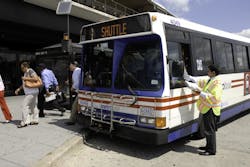Simultaneously, the increasing urbanization within developed nations like the U.S. may also drive up the need for more mass transit service – and thus you can see how deploying more commercial trucks and more city buses on already crowded urban streets may take the term “traffic congestion” to a whole new level.
[FYI: IBM did some interesting research on ways to “unknot” city roadways about five years ago. You can read that story here.]
So as trucking firms start figuring out how to transport more goods in and out of more urbanized locales, it would be a good idea to see how mass transit might be affected by the same trends – and how growth in transit service might impact the urban delivery schemes designed by motor carriers.
An interesting place to start is a new study conducted by the non-profit group TransitCenter called Who’s on Board: The 2014 Mobility Attitudes Survey. Based on a massive survey of 11,842 respondents across 46 metropolitan statistical areas (MSAs) in the U.S., TransitCenter said its poll spans the country’s “full geography” to include cities with well-developed transit systems as well as those that lack them.
The group stressed, too, that its survey sample also ensured minimum quotas for all age groups, allowing the study to compare different generations, geographies, and neighborhood types.
Here are some findings to ponder:
- Riders of all ages and in all regions place the greatest value on factors such as travel time, proximity, cost, and reliability above safety, frequency, and perks like Wi-Fi when choosing whether or not to take public transportation.
- Americans under 30 are 2.3 times more likely to ride public transit than Americans age 30 to 60, and 7.2 times more likely than Americans over 60. Even after controlling for other factors, older people are less likely to ride transit than younger people.
- Parents are just as likely as non-parents to use transit, when factors like age and place of residence are controlled for.
- Americans with a bachelor’s or graduate degree are no more or less likely to use transit than those who have not finished college, when other variables are controlled for. Current students, though, are much more likely to take transit than non-students who are otherwise similar to them.
- Personal values and personality characteristics have a considerable effect on travel preferences, with “core personality traits” affect travel choices directly as well as indirectly, by affecting the type of neighborhood people choose to live in.
- The top predictor of whether or not someone in the U.S. uses transit is what type of neighborhood they live in – especially interesting when many Americans in TransitCenter’s poll said they would prefer to live in a different type of neighborhood than they do now.
- There is a high, unmet demand for neighborhoods with a mix of housing, retail, and commercial space as 58% of survey respondents said their ideal neighborhood contained “a mix of houses, shops, and businesses,” yet only 39% currently live in that type of neighborhood.
Yet the type of transit system selected to move people from one urban location to another is going to directly impact freight flows as well as, for example, more buses could quickly create more crowded streets.
Many, of course, feel more freight should be shifted to railroads, thus reducing the number of trucks on the road. Yet trains cannot make direct-to-store deliveries to the city deli or suburban grocery store – a point Phil Byrd, president and CEO of Bulldog Hiway Express and current chairman of the American Trucking Assns. (ATA) stressed in a speech back in March.
And even the growth of intermodal service – the interlining of rail and truck service – is bumping into a host of issues that could stymie its growth potential in the near future.
There’s also a “personal connection” to transit systems that doesn’t truly exist in other modes of travel, argued David Bragdon, TransitCenter’s executive director, in his group’s study, and that needs to be considered in all of this as well.“In 2013, advocates, planners, and policymakers were abuzz with the 10.7 billion rides taken on transit, an all-time U.S. record,” he said. “Yet the discussion focused too much on the sheer number of rides, without a deep look at the riders themselves, and particularly the changing attitudes that are propelling recent ridership increases.”
Bragdon (above) emphasized that Americans interact with public transit every day, whether or not they are one of those 10.7 billion rides, and their opinions of it are shaped throughout childhood, over each commute home, at every bus stop, and in every traffic jam.
“Transit is personal,” he stressed. “Unlike the sewer systems, the power grid, and telecommunications infrastructure, transit can evoke pride, frustration, and even fear. It can shape our most personal decisions about where we live and work.”
And those “personal decisions” are also going to create a ripple effect in the freight world, too: thus something trucking should keep its eye upon as the industry crafts its freight hauling plans for the future..



